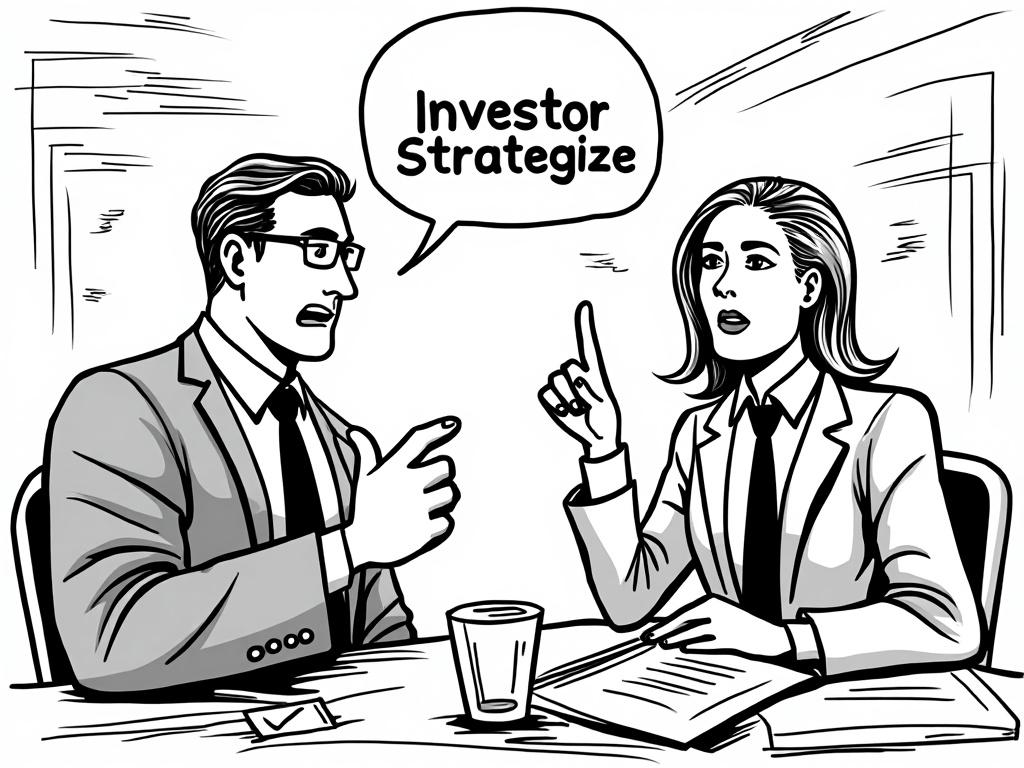
How to Invest $100,000: Strategies for a Larger Sum
Reading time: 12 minutes
Ever stared at a $100,000 investment opportunity and felt simultaneously excited and overwhelmed? You’re holding the keys to financial transformation, but the weight of making the wrong decision can be paralyzing. Let’s turn that anxiety into strategic confidence.
Key Investment Insights:
- Diversification becomes your superpower at this investment level
- Tax efficiency can save you thousands annually
- Professional guidance pays for itself with larger sums
Here’s the straight talk: Investing $100,000 isn’t just about picking stocks—it’s about architecting a wealth-building machine that works while you sleep.
Table of Contents
- Pre-Investment Financial Health Check
- Core Investment Strategies for $100K
- Strategic Asset Allocation Models
- Investment Platforms and Professional Management
- Tax-Efficient Investment Approaches
- Common Pitfalls and How to Avoid Them
- Your Wealth-Building Blueprint
- Frequently Asked Questions
Pre-Investment Financial Health Check
Before deploying your $100,000, let’s ensure your financial foundation is rock-solid. Think of this as building a house—you wouldn’t start with the roof.
Emergency Fund Verification
Quick scenario: Your car breaks down, and simultaneously, your company announces layoffs. Without 3-6 months of expenses saved separately from your investment funds, you might be forced to liquidate investments at the worst possible time. Never invest money you might need within two years.
Debt Assessment Strategy
Here’s where mathematics meets psychology. Credit card debt at 18% interest will consistently outpace most investment returns. However, low-interest debt like mortgages (around 3-4%) might be worth keeping while investing for higher returns.
Debt Decision Framework:
- High-interest debt (>7%): Pay off first
- Medium-interest debt (4-7%): Consider splitting approach
- Low-interest debt (<4%): Invest while maintaining payments
Core Investment Strategies for $100K
With $100,000, you’ve reached the threshold where sophisticated strategies become accessible. Let’s explore approaches that weren’t feasible with smaller amounts.
The Three-Bucket Approach
Professional wealth managers often use this time-tested framework:
Bucket 1: Safety Net (20-30%)
High-yield savings accounts, CDs, Treasury bills. This isn’t exciting, but it’s your financial insurance policy. Current high-yield savings rates around 4.5% make this bucket more attractive than in recent years.
Bucket 2: Growth Engine (50-70%)
This is where wealth multiplication happens. Index funds, ETFs, individual stocks, and REITs form your core holdings. The key? Consistent contributions and patience.
Bucket 3: Speculation Station (5-15%)
Cryptocurrency, individual growth stocks, or sector-specific plays. Think of this as your “lottery ticket” allocation—money you can afford to lose entirely.
Index Fund Excellence
Warren Buffett famously won a 10-year bet against hedge funds using simple S&P 500 index fund investing. With $100,000, you can access institutional-class funds with expense ratios as low as 0.03%.
Consider this case study: Sarah invested $100,000 in 2013 across three index funds: 60% total stock market, 30% international stocks, 10% bonds. By 2023, despite market volatility including COVID-19, her portfolio grew to approximately $195,000—nearly doubling with minimal effort.
Strategic Asset Allocation Models
Asset allocation determines roughly 90% of your investment returns, according to academic research. Here’s how to structure your $100,000 across different investment vehicles.
| Portfolio Type | Stocks | Bonds | Real Estate | Alternatives | Risk Level |
|---|---|---|---|---|---|
| Conservative Growth | 50% | 35% | 10% | 5% | Low-Medium |
| Balanced Growth | 70% | 20% | 7% | 3% | Medium |
| Aggressive Growth | 85% | 5% | 5% | 5% | High |
| Income-Focused | 40% | 45% | 15% | 0% | Low |
Geographic Diversification Strategy
Don’t put all your eggs in the American basket. International exposure through emerging markets and developed countries can reduce volatility while capturing global growth. Consider allocating 20-30% internationally.
Sector-Specific Considerations
Technology has dominated the past decade, but history shows sector leadership rotates. Healthcare, consumer staples, and financial services offer different risk-return profiles and economic cycle exposures.
Investment Platforms and Professional Management
With $100,000, you’ve crossed the threshold where premium services and lower fees become available. Let’s examine your options.
Robo-Advisors vs. Human Advisors
Robo-advisors like Betterment and Wealthfront offer sophisticated algorithms at 0.25-0.50% annual fees. They excel at tax-loss harvesting and rebalancing but lack personalized financial planning.
Human advisors typically charge 1% annually but provide comprehensive financial planning, estate planning guidance, and emotional coaching during market downturns—often worth the premium during volatile periods.
Self-Directed Investing Platforms
Platforms like Fidelity, Schwab, and Vanguard offer commission-free trading and access to institutional-quality funds. With $100,000, you might qualify for premium account features and dedicated support.
Platform Comparison: Annual Costs on $100K
$50 (0.05%)
$300 (0.30%)
$1,000 (1.00%)
$1,500 (1.50%)
Tax-Efficient Investment Approaches
Tax efficiency can add thousands to your returns annually. With $100,000, these strategies become particularly powerful.
Account Type Optimization
Tax-advantaged accounts first: Max out 401(k), IRA, and HSA contributions before taxable investing. These accounts offer immediate tax benefits or tax-free growth.
Asset Location Strategy: Place tax-inefficient investments (bonds, REITs) in tax-advantaged accounts, while holding tax-efficient index funds in taxable accounts.
Tax-Loss Harvesting
This advanced technique involves selling losing investments to offset gains from winners. With $100,000, automated tax-loss harvesting can save $200-500 annually in taxes.
Real-world example: James held $10,000 in a tech stock that dropped 20%. By selling and immediately buying a similar tech ETF, he captured a $2,000 tax loss while maintaining market exposure, saving $440 in taxes at his 22% bracket.
Common Pitfalls and How to Avoid Them
Large sums attract big mistakes. Let’s navigate the most dangerous traps.
The “All-at-Once” Trap
Investing $100,000 immediately might seem logical, but dollar-cost averaging over 6-12 months can reduce timing risk. Consider investing $8,000-15,000 monthly rather than everything at once.
Overconfidence Bias
Having $100,000 to invest can create dangerous overconfidence. Stick to your allocation plan regardless of market conditions or hot stock tips. According to Dalbar research, the average investor underperforms the market by 3-4% annually due to emotional decision-making.
The Complexity Trap
More money doesn’t require more complicated strategies. Simple, low-cost index fund portfolios often outperform complex alternatives. As Vanguard founder Jack Bogle said, “Don’t look for the needle in the haystack. Just buy the haystack.”
Your Wealth-Building Blueprint
Here’s your actionable roadmap for transforming $100,000 into lasting wealth:
Phase 1: Foundation Setting (Month 1)
- Complete emergency fund verification
- Eliminate high-interest debt above 7%
- Choose your investment platform and account types
- Define your risk tolerance and time horizon
Phase 2: Strategic Deployment (Months 2-6)
- Implement dollar-cost averaging schedule
- Build core portfolio using low-cost index funds
- Set up automatic rebalancing quarterly
- Configure tax-loss harvesting if available
Phase 3: Optimization and Growth (Ongoing)
- Review and rebalance quarterly
- Increase contributions with income growth
- Stay educated through reputable financial sources
- Resist emotional decision-making during volatility
Remember: wealth building is a marathon, not a sprint. Your $100,000 today, with consistent 7% annual returns, becomes $200,000 in 10 years and $400,000 in 20 years through the magic of compound growth.
What legacy will your investment decisions create for your future self? The choices you make today with this $100,000 will echo through decades of financial freedom—or constraint. As global markets evolve and new opportunities emerge, your disciplined approach to wealth building positions you to capitalize on tomorrow’s possibilities while protecting against today’s uncertainties.
Frequently Asked Questions
Should I invest all $100,000 at once or gradually over time?
Dollar-cost averaging over 6-12 months often works better psychologically and can reduce timing risk. While lump-sum investing statistically wins about 60% of the time, spreading investments can help you sleep better during volatile periods. Consider investing $8,000-12,000 monthly if you’re concerned about market timing.
How much should I allocate to international investments?
Most financial advisors recommend 20-40% international allocation to reduce concentration risk in US markets. International developed markets offer stability and diversification, while emerging markets provide higher growth potential with increased volatility. Start with 25% international and adjust based on your risk tolerance.
When does it make sense to hire a financial advisor?
Consider professional help if you lack time for research, feel overwhelmed by choices, or need comprehensive financial planning beyond investing. With $100,000, you qualify for quality advisory services. The 1% annual fee often pays for itself through tax optimization, behavioral coaching, and avoiding costly mistakes during market downturns.

Article reviewed by Enzo Almeida, Business Scaling Expert | Growth Strategist | Driving Expansion in Emerging Markets, on July 3, 2025
